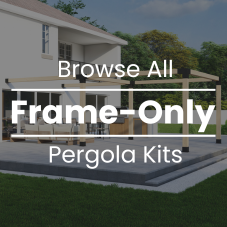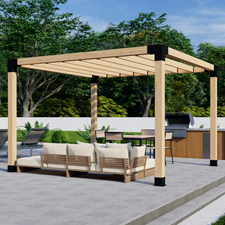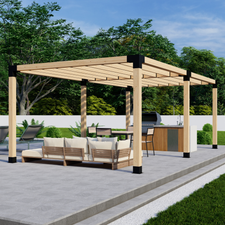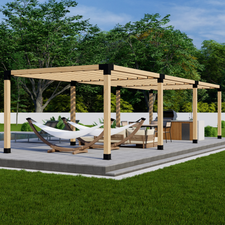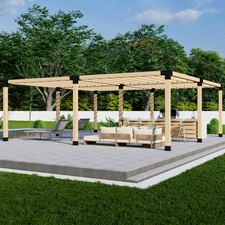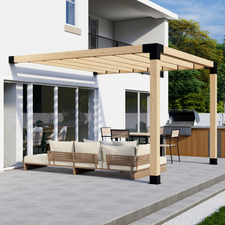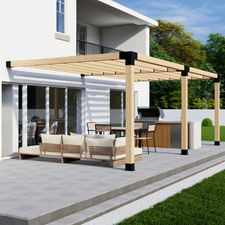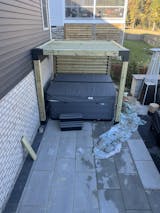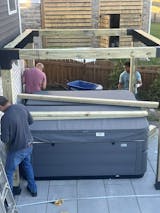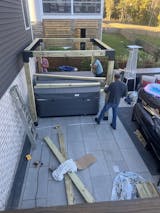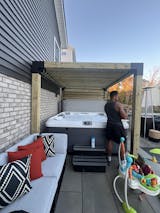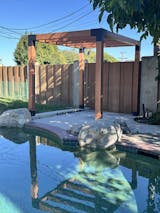What size of wood do I need to buy?
The wood sizes listed on this page & throughout our website use standard U.S. lumber sizes (where the actual dimensions are a half-inch smaller than the name implies):
- Our 4x4 brackets are designed for "four-by-fours" (actual size: 3.5" x 3.5")
- Our 2x4 brackets are designed for "two-by-fours" (actual size: 1.5" x 3.5")
- Our 6x6 brackets are designed for "six-by-sixes" (actual size: 5.5" x 5.5")
- Our 2x6 brackets are designed for "two-by-sixes" (actual size: 1.5" x 5.5")
If you stick with these standard lumber sizes, the wood will slide right into the brackets and fit perfectly.
Make sure NOT to get "rough-cut" of "rough-sawn" lumber, which is slightly bigger than standard dressed lumber. Rough-cut lumber will not fit into our brackets.
What type of wood do you recommend?
In general, any straight dry lumber will work just fine. Some types of wood may just require a little more maintenance than others. The two most common types of wood to use are western red cedar and redwood. They are naturally insect- and rot-resistant and have natural oils & resins that make them more resilient to the elements. Another great option is pressure-treated pine, as the pressure-treating process makes the wood more weather- and insect-resistant. This is far from a complete list of lumber options; there are many other types of wood that will work great.
What height do you recommend for the posts?
We recommend using 8-foot lumber for the pergola's posts. The parts list and estimated costs shown in the 'Required Lumber & Estimated Cost' section (above) assumes that you will be using 8-foot lumber. That said, many of our customers opt for 10-foot posts instead, in which case we recommend adding corner support brackets to make the pergola more stable. Posts should not be taller than 10 feet.
back to top
Is a 12x12 pergola really exactly 12' x 12'?
The answer depends on whether you're referring to the inside dimensions of the pergola's roof (i.e. the "roof opening") or the outside dimensions of the roof (i.e. the full outside-edge-to-outside-edge measurement).
When we say a pergola is 12' x 12', we're referring to the roof opening (i.e. the inside dimensions of the roof) which is exactly 12' wide x 12' deep.
But the overall outside-edge-to-outside-edge dimensions of a "12x12 pergola" built using 4x4 brackets will be 12 ft. 7.3 in. x 12 ft. 7.3 in. (Note: If you're using 6x6 brackets, the outside dimensions will be 12' 11.3" x 12' 11.3".)
To give the pergola maximum strength and stability, we've designed our 3-, 4- and 5-arm brackets (as well as the "L" and "T" brackets, for that matter) to have the vertical post go all the way to the top of the brackets. Thus, the horizontal roof beams only slide in to the end of the horizontal channel they're sitting in (rather than going all the way through the bracket). To put it another way, a roof beam only slides halfway into a 3-arm corner bracket (since the "other half" of the bracket is already occupied by the top part of the vertical post going down to the ground).
So if you're looking at the roof of a pergola with 12-foot-long roof beams, you've got the following (going from left to right):
- 3.65 inches of the "left half" of the 3-arm corner bracket on the left side (which is occupied by the top part of the left vertical post) +
- 12 feet for the 12' long roof beam (with approximately 3.5 inches sitting inside the horizontal channel of the 3-channel corner bracket on both the left and the right side) +
- 3.65 inches of the "right half" of the 3-arm corner bracket on the right side (which is occupied by the top part of the right vertical)
This gives you a total edge-to-edge width of 12 ft. 7.3 in. (But again, the inside dimensions of the roof opening are exactly 12' x 12'.)
What if you want the edge-to-edge width and/or depth to be exactly 12 feet? Simply use a circular saw (or hack saw or miter saw) to trim 7.3 inches off the 12-foot posts. This will make the overall edge-to-edge dimensions exactly 12' x 12' and the inside dimensions of the roof opening 11' 4.7" x 11' 4.7". (Important Note: Our shade canopies are specifically designed to fit roof openings that are exactly 8x8, 8x10, 8x12, 10x10, 10x12 and 12x12. If you're purchasing a kit that includes a shade canopy, you cannot trim down the roof beam posts.)
How many people will I need to assemble my pergola?
The majority of the steps in the assembly process can easily be done by just two people. However, there are a couple steps that will require more people (typically four people for a pergola using 4x4 brackets and six people for one using 6x6 brackets) for just a few minutes here and there. Most tasks (including assembling the roof frame and even adding roof rafters) are completed on the ground. The entire building process should only take 2-3 hours.
If you're curious about the building process, please take a few minutes to read through the fully-illustrated assembly instructions.
How do I make sure the roof rafters (and wall slats) are spaced evenly?
Click the following links for detailed, illustrated instructions for evenly spacing roof rafters and privacy wall slats.
back to top
Do you provide enough screws to fill every hole of every bracket?
Yes, we do. Putting a screw in every hole is technically overkill (and some people would argue that it puts too much stress on the lumber and could cause cracks & fissures in the wood over time). But some customers really want every hole filled, so we include enough screws to fill every hole (plus a few extra). Really, you only need to put 2 screws into each bracket face (using the 2 outermost holes in instances when the face of the bracket has 4 holes).
What wind speeds can Zen Pergolas withstand?
When installed correctly following the assembly instructions, Zen Pergolas can withstand winds of up to 50 mph. If you live in an area that experiences wind gusts in excess of 50 mph, we recommend adding corner support brackets. Not only do they look beautiful, but they also make the pergola structure more stable and secure. We also recommend checking your local building codes to make sure your pergola is mounted to the ground and/or house or other structure properly.
If you buy a kit that includes one or more shade canopies, we recommend taking them down in windy conditions (i.e. 30+ mph winds), during storms, and also through the winter months when you're not enjoying your pergola.
I need help figuring out what brackets I need. Can you help?
Absolutely! We realize that piecing together the perfect modular pergola can be complex. That's why we have pergola design experts standing by and ready to help. You can reach us during regular business hours at (877) 760-6992. You can also send us an email at support@zenpergolas.com or live chat with us.
Are Zen brackets & other parts covered by a warranty?
Yes. Our steel brackets are covered by a 5-year limited warranty, and our shade canopies & hammocks are covered for 1 year. You can learn more here.
back to top
How big can I make my pergola?
Zen brackets are modular, meaning you can use them to make your pergola as wide and as deep as you want by simply adding more "blocks" (or sections). For each individual block, we recommend using no longer than 12' posts for the roof beams, meaning that each block would be approximately 12' wide x 12' deep.
(To be more precise, if you use untrimmed 12-foot posts for the roof beams, a 1-block pergola built using 4x4 brackets will actually measure 12 ft. 7.3 in. wide x 12 ft. 7.3 in. deep from outside edge to outside edge. This is because the 3-, 4- and 5-arm brackets are designed to have the vertical posts go all the way to the top of the bracket, meaning that the horizontal roof beams stop at the end of the horizontal channel they sit in rather than going all the way through the bracket.)
If you want your pergola's overall width or depth (but not both) to be greater than 12' but less than 24', it will have 2 blocks (i.e. a 2x1 grid).
If you want both the width and depth to be greater than 12' but less than 24', it will have 4 blocks (i.e. a 2x2 grid).
Although we don't have every possible width/depth combination listed out, it may be helpful to take a look at the Shop by Dimension page.
What hardware should I use to secure the base brackets to the ground (and the wall-mount brackets to my house)?
Due to the fact that there are so many different surfaces that you can mount/anchor the base brackets and wall-mount brackets to (along with the fact that HOAs and cities sometimes have unique requirements), we can't advise you on what type of hardware you should use. We recommend that you speak with a sales associate at your local home improvement or hardware store (i.e. Lowes, Home Depot, Ace Hardware, etc.) about what type of hardware they recommend for your specific location and the surface/material you're anchoring the brackets to.
How are the shade canopies sized? How do I ensure a good fit?
Our shade canopies are sized to fit roof openings (i.e. inside-of-post to inside-of-post) that are exactly 8x8, 8x10, 8x12, 10x10, 10x12 and 12x12. The shade canopies themselves are 4 inches shorter than their names imply (e.g. an "8x12 canopy" is actually 7' 8" by 11' 8") so you can pull the canopy straps tight and have a snug fit.
As explained in one of the FAQs above, all of the brackets used for building the frame of the roof are designed to have the vertical posts go all the way to the top of the bracket, which means that the horizontal roof beams stop at the end of the horizontal channel arm they sit in (rather that going all the way through the bracket). Accordingly, whatever length of post you use for the roof beams will be the exact size of the roof opening. So if you use untrimmed 8' and 12' posts for the roof, your roof opening will be exactly 8' x 12' and fit an 8x12 shade canopy perfectly.
How do I care for shade canopies?
First and foremost, never use shade canopies above or around open flames or other heat sources.
Second, make sure to take canopies down in winds exceeding 30 mph. You should also take them down in severe storms and through the winter months (during which time you're probably not using your pergola anyway).
Before storing your shade sail long-term during the off-season, use a mild detergent and soft brush to gently wash the canopy. Then thoroughly rinse the canopy with water and let it dry completely. If you're storing the canopy indoors, you can just store it in the bag that's included with the canopy. If you're storing it outdoors, though, we recommend storing it in an airtight container to keep out moisture and insects.
back to top


 Free Shipping - delivered by
-
Free Shipping - delivered by
-
![]() Coupons - 1 available Reveal
Coupons - 1 available Reveal













